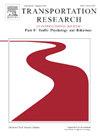多用户虚拟现实环境下行人与微移动的安全行为与碰撞风险
IF 3.5
2区 工程技术
Q1 PSYCHOLOGY, APPLIED
Transportation Research Part F-Traffic Psychology and Behaviour
Pub Date : 2025-04-30
DOI:10.1016/j.trf.2025.04.012
引用次数: 0
摘要
理解行人和街道上的微型交通工具之间复杂的相互作用,特别是随着电动滑板车的使用越来越多,是一个持续的挑战。本研究试图通过调查人行道使用者的碰撞风险来填补这一空白,特别关注规避行为和人行道配置。本研究的分析框架包括三个主要目标:(1)识别行人和两种微型交通工具(自行车和电动滑板车)在规避行为和风险方面的差异;(2)研究行人与微机动车辆同时规避行为对碰撞风险的影响;(3)探讨车道分道对人行道使用者的实际意义。共有102名参与者参加了虚拟现实环境实验,每人分别扮演行人、骑自行车者和电动滑板车使用者。规避行为、风险和风险评估是VR环境中行为和认知的关键指标,通过行为观察和问卷调查进行量化。研究结果表明,采取规避行动可以显著降低风险,特别是对于微型车辆,微型车辆用户的早期规避行动对提高行人安全起着至关重要的作用。此外,三条车道的人行道在降低行人和电动滑板车之间的风险和风险评估方面被证明是有效的。从本研究中获得的行为和风险模型的见解有可能增强对行人安全的理解,并降低行人与微移动车辆之间的风险。本文章由计算机程序翻译,如有差异,请以英文原文为准。
Safety behaviors and collision risks between pedestrians and micro-mobilities in multi-user virtual reality environments
Understanding the complex interactions between pedestrians and micro-mobilities on streets, especially with the increasing use of e-scooters, presents a persistent challenge. This study seeks to fill this gap by investigating the collision risk among sidewalk users, focusing specifically on evasive actions and sidewalk configurations.The analytical framework of this study encompasses three main objectives: (1) identifying differences in evasive actions and risks among pedestrians and the two types of micro-mobilities—bicycles and e-scooters; (2) investigating the impact of concurrent evasive actions between pedestrians and micro-mobilities on collision risks; and (3) exploring practical implications of lane separations for sidewalk users. A total of 102 participants took part in VR environment experiments, each engaging in three sessions as a pedestrian, bicycle rider, and e-scooter user. Evasive actions, risk, and risk assessment serve as pivotal metrics of behaviors and cognition in the VR environment, quantified through behavioral observations and questionnaires. The study’s findings illustrate that taking evasive actions significantly reduces risks, particularly regarding micro-vehicles, where early evasive actions by micro-vehicle users play a crucial role in enhancing pedestrian safety. Additionally, a three-lane sidewalk proves effective in diminishing risks and risk assessments between pedestrians and e-scooters. The insights gained into behaviors and risk models from this study hold the potential to enhance understanding of pedestrian safety and mitigate risks between pedestrians and micro-mobility vehicles.
求助全文
通过发布文献求助,成功后即可免费获取论文全文。
去求助
来源期刊
CiteScore
7.60
自引率
14.60%
发文量
239
审稿时长
71 days
期刊介绍:
Transportation Research Part F: Traffic Psychology and Behaviour focuses on the behavioural and psychological aspects of traffic and transport. The aim of the journal is to enhance theory development, improve the quality of empirical studies and to stimulate the application of research findings in practice. TRF provides a focus and a means of communication for the considerable amount of research activities that are now being carried out in this field. The journal provides a forum for transportation researchers, psychologists, ergonomists, engineers and policy-makers with an interest in traffic and transport psychology.

 求助内容:
求助内容: 应助结果提醒方式:
应助结果提醒方式:


